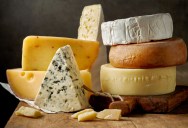A Popular French Cheese Could Disappear Because Of A Problem With Mold Gene Diversity

Cheese is one of those rare thing in this world that is almost universally liked.
I mean, even if you’re lactose intolerant and can’t eat it, you still want to.
In the future, though, a decline in biodiversity could make at least one French cheese nearly impossible to get.
Camembert is a soft cheese that, according to the French National Center for Scientific Research (CNRS), is “on the verge of extinction.”
Other similar cheeses, like brie and some varieties of blue cheese, are also suffering due to the same circumstances.

Those circumstances are part of a big problem: a collapse in microbial diversity.
Every piece of French cheese is actually an ecosystem that consists of fungi and bacteria that turn fats and proteins into hundreds of different compounds. Those compounds are what produce the flavors, smells, and textures that make the cheeses unique. Some of the most famous French cheeses, like camembert, now rely on a single strain of fungi that’s at risk of going extinct.
It’s a stark reminder that life’s finer things – and a whole bunch of more common stuff – depend on a health biodiversity around the world.
Cheese is made by mixing fresh milk with bacteria and fungi that include both yeasts and molds. The resulting different microbe melanges produce different varieties of cheese. For a hundred or so years, most high quality camembert and brie have been made from a particular strain of P. biforme (Penicillium camemberti) that’s fast growing and produces a fluffy, white mold.

Since it became favored, the other mold strains that were used previously have vanished. This is a good thing for people who want to know exactly what they’re getting when they buy their brie, but as we should know by now, uniformity comes at a cost.
The preferred albino strain can’t breed on its own in order to produce new genetic diversity. Instead, cheesemakers have to clone it – and it’s hard to do that for so long without introducing harmful errors to its genome. In addition to reproduction issues, P. camemberti picked up mutations that interfere with its ability to produce spores. This makes it difficult for cheesemakers to use their only available fungus for making brie and camembert.
You might not notice any difficulty in getting your cheese right now, but according to experts, it’s going to be more and more difficult to produce in the near future.
In general, the foods we eat are becoming less resilient – from other soft cheeses like blue, Gorgonzola, and Roquefort, to fruit like banana, many scientists are close to pushing the panic button.
As author Dan Saladino points out in Eating to Extinction: The World’s Rarest Foods and Why We Need to Save Them, if any of these unique strains gets wiped out by a particular pathogen, we have nothing else to fall back on.

Different strains of most plants and animals have different strengths and weaknesses, so there is strength in diversity.
Tatiana Giraud, who works for CNRS, is concerned.
“When you lose diversity within a species, you lose adaptability.”
There is a way to save camembert and brie, but consumers might have to learn to be okay with some diversity of taste, color, etc, as well.
Penicillium biforme has a lot of diversity, and the molds are able to reproduce on their own. Different strains could, of course, affect taste and texture, among other things.
If we’ve learned anything at this point, I think it should be that we’re all better off when we embrace our diversity instead of fighting it.
Then again, as a society, we’re pretty slow to accept change these days.
If you found that story interesting, learn more about why people often wake up around 3 AM and keep doing it for life.

Sign up to get our BEST stories of the week straight to your inbox.




